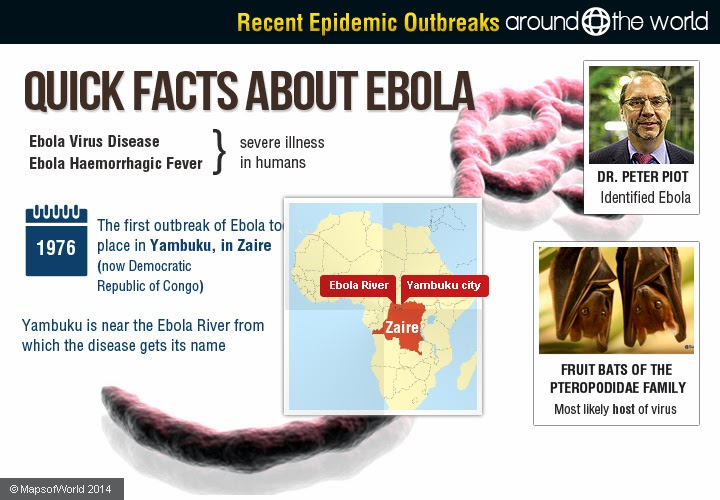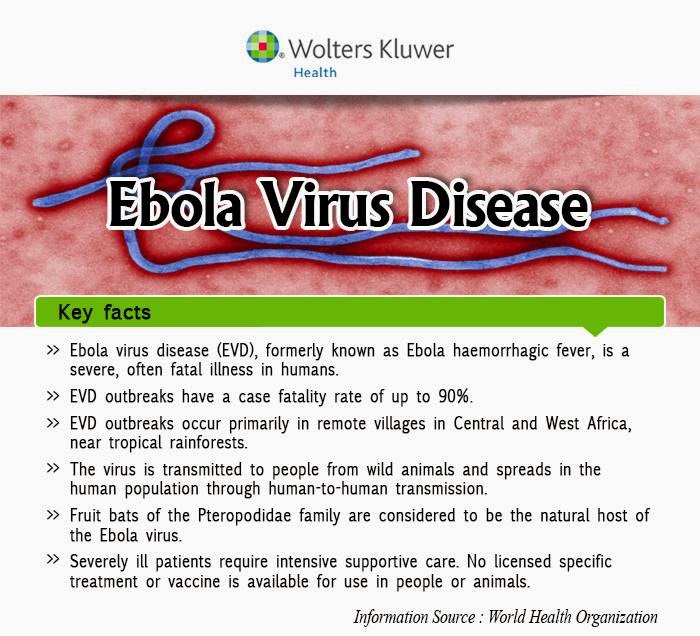Ebola Fast Facts
Wednesday, April 1, 2015
Add Comment

The current Ebola hemorrhagic fever outbreak has been described as the largest in history and the first of its kind in West Africa. The disease is related to but distinct from Lasa fever which had an outbreak in Nigeria in th 1980s. Four types affecting human beings include: Ebola Zaire, Ebola Sudan, Ebola Ivory Cost and Ebola Bundibugyo.
Ebola hemorrhagic fever affects both animals (primates like monkeys) and human beings and can be transmitted between the two species. Transmission is mainly through body fluids entering broken skins or mucosa membranes. Ebola virus causes severe damages to the major organs of the body and often causes blood clotting failure with massive internal bleeding; hence the name hemorrhagic fever. It is a deadly disease without intensive supportive treatment.
The current FDA approved antiviral drugs are ineffective against Ebola virus, hence the death rate from Ebola infection is up to 95%. Researchers have noticed a continuous change in the genetic make up of Ebola virus between 2014 and 2024, as it switches human hosts. The current outbreak has been traced to an initial animal to human transmission in Central Africa, with human to human spread to West Africa.
Ebola hemorrhagic fever affects both animals (primates like monkeys) and human beings and can be transmitted between the two species. Transmission is mainly through body fluids entering broken skins or mucosa membranes. Ebola virus causes severe damages to the major organs of the body and often causes blood clotting failure with massive internal bleeding; hence the name hemorrhagic fever. It is a deadly disease without intensive supportive treatment.
The current FDA approved antiviral drugs are ineffective against Ebola virus, hence the death rate from Ebola infection is up to 95%. Researchers have noticed a continuous change in the genetic make up of Ebola virus between 2014 and 2024, as it switches human hosts. The current outbreak has been traced to an initial animal to human transmission in Central Africa, with human to human spread to West Africa.

As of October 14, 2014, over 2470 people have been infected and over 1300 people have been killed by Ebola virus in West Africa. These numbers are said to be increasing exponentially. Only one death has been reported in Dallas Texas in the US, of a Liberian male who contracted the disease before leaving for US. One of the nurses who attended to the dead patient has just been diagnosed with Ebola infection, is not in critical condition.
Failure of personal protective equipment (PPE) protocol has been suggested, and US healthcare workers are getting actively prepared to handle potential outbreaks in their institutions. All healthcare workers presented with patients with high fever must ask about their travel history and instantly commence universal precautionary measures.
The National Institute of Health (NIH) has warned the US Congress about possible Ebola epidemic and even pandemic without aggressive national and international Ebola infection preventive measures. Some legislators are calling for restriction of inbound flights from Liberia, Sierra Leone, or Guinea. However, the US Congress is yet to have a debate on that call.
Failure of personal protective equipment (PPE) protocol has been suggested, and US healthcare workers are getting actively prepared to handle potential outbreaks in their institutions. All healthcare workers presented with patients with high fever must ask about their travel history and instantly commence universal precautionary measures.
The National Institute of Health (NIH) has warned the US Congress about possible Ebola epidemic and even pandemic without aggressive national and international Ebola infection preventive measures. Some legislators are calling for restriction of inbound flights from Liberia, Sierra Leone, or Guinea. However, the US Congress is yet to have a debate on that call.

The US Congress has approved mandatory screening of all passengers from West Africa for high fever and other symptoms at the international airports. All travellers entering the US with symptoms of Ebola infection must be observed in isolation for a specified period before they can enter the country.
If Ebola symptoms presented after visitors have made contact with US residents, their contacts must also be traced and observed in isolation, The homes and surroundings of their hosts are also actively disinfected by specially equipped CDC crew. The same precaution was taken for the first US patient recently diagnosed with Ebola hemorrhagic fever in Texas. Contact with potential Ebola patients must be avoided without adequate personal protective wears.
A $50 Billion dollar public health aid package for the affected countries has also been approved by US congress, along with over 1000 military personnel to help with Ebola epidemic containment efforts. An Ebola Response Team has also been established in the US by the Center for Disease Prevention (CDC) to step in immediately the diagnosis of the Ebola is confirmed in any part the country. The team is to help with patient management expertise, provision and supervision of proper use of personal protective equipment (PPE), transportation, environmental disinfection, and more.

New vaccine testing on US Ebola patients brought back from West Africa is providing modest hope of arresting the speed of Ebola infection. Ebola virus is not airborne, so there is no need for panic among unexposed individuals, who have made no direct contacts with infected patients. Ebola virus produces symptoms after up to 21 days, when and only when it becomes infectious
The symptoms of Ebola hemorrhagic fever include: fever of up to 103°F, flu-like symptoms, stomach upset, general body ache, muscle weakness, loss of appetite, diarrhea, nausea, vomiting, malaise, and mild headache, skin rashes, sore throat, and gastrointestinal bleeding. In severe cases coma and death may follow hypotensive shock.
These symptoms are produced by viral invasion of the blood, liver, kidneys, and other vital organs, including the central nervous system. Toxic pyrogens disrupt the hypothalamic thermoregulatory system, allowing the body temperature to rise up to 103°F. Severe damage to the liver cuts off production of clotting factors leading to generalized bleeding disorder.
The symptoms of Ebola hemorrhagic fever include: fever of up to 103°F, flu-like symptoms, stomach upset, general body ache, muscle weakness, loss of appetite, diarrhea, nausea, vomiting, malaise, and mild headache, skin rashes, sore throat, and gastrointestinal bleeding. In severe cases coma and death may follow hypotensive shock.
These symptoms are produced by viral invasion of the blood, liver, kidneys, and other vital organs, including the central nervous system. Toxic pyrogens disrupt the hypothalamic thermoregulatory system, allowing the body temperature to rise up to 103°F. Severe damage to the liver cuts off production of clotting factors leading to generalized bleeding disorder.
In general, epithelial cells lining the skin and mucous membranes normally release interferon - alpha (IFN-alpha) from CD4 T lymphocytes and immunoglobulin-M (IgM) from CD8 B- lymphocytes immediately invading viruses are detected. IFN-alpha activates natural killer (NK) cells which destroy the viruses. About 24 hours later activated CD4 T-Helper lymphocytes switch immunoglobulin production from IgM to IgA which protects secretory surfaces from bacterial invasion. When the viral load overwhelms this natural defense mechanism, symptoms of the disease begin to manifest. Vaccine development is aimed at stimulating increased production of natural killer cells specifically targeted at Ebola virus genome.
From what is happening in West Africa, the World Health Organization (WHO) has warned that without aggressive preventive measures and logistic supports, there might soon be up to 10,000 new Ebola hemorrhagic fever patients daily. The US president has also called on those nations who have some resources to offer to step up to the plate and send aid packages to Sierra Leone, Liberia and Guinea.
From what is happening in West Africa, the World Health Organization (WHO) has warned that without aggressive preventive measures and logistic supports, there might soon be up to 10,000 new Ebola hemorrhagic fever patients daily. The US president has also called on those nations who have some resources to offer to step up to the plate and send aid packages to Sierra Leone, Liberia and Guinea.

0 Response to "Ebola Fast Facts"
Post a Comment